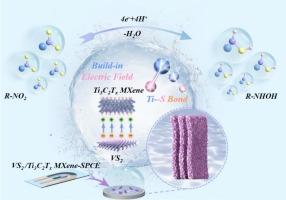Interfacial engineering of VS2/Ti3C2Tx MXene heterojunctions for portable electrochemical sensing of nitrofurantoin residues in food and water samples
IF 9.8
1区 农林科学
Q1 CHEMISTRY, APPLIED
引用次数: 0
Abstract
The contamination of nitrofurantoin (NFT) antibiotics in the food chain poses significant threats to environmental and public health, emphasizing the urgent need for rapid and portable detection. This study presents an electrochemical sensor based on a 2D/2D van der Waals heterojunction of VS2 and Ti3C2Tx MXene integrated onto a screen-printed carbon electrode (SPCE). Interfacial engineering of Ti![]() S bonds creates efficient charge transfer pathways and a directional built-in electric field, enhancing charge dynamics and electroreduction efficiency. The VS2/Ti3C2Tx MXene-SPCE sensor shows an ultralow detection limit of 4.7 nM, a wide linear range (0.01–400 μM), and high stability with strong resistance to interference. Its practical applicability was validated by successful NFT detection in tap water, lake water, milk, and honey, yielding satisfactory results. This work highlights the catalytic potential of VS2/ Ti3C2Tx MXene heterojunctions and demonstrates the sensor as a promising tool for environmental monitoring and food safety.
S bonds creates efficient charge transfer pathways and a directional built-in electric field, enhancing charge dynamics and electroreduction efficiency. The VS2/Ti3C2Tx MXene-SPCE sensor shows an ultralow detection limit of 4.7 nM, a wide linear range (0.01–400 μM), and high stability with strong resistance to interference. Its practical applicability was validated by successful NFT detection in tap water, lake water, milk, and honey, yielding satisfactory results. This work highlights the catalytic potential of VS2/ Ti3C2Tx MXene heterojunctions and demonstrates the sensor as a promising tool for environmental monitoring and food safety.


VS2/Ti3C2Tx MXene异质结用于便携式电化学检测食品和水样中呋喃呋喃残留的界面工程
呋喃呋喃(NFT)抗生素在食物链中的污染对环境和公众健康构成重大威胁,因此迫切需要进行快速和便携式检测。本研究提出了一种基于VS2和Ti3C2Tx MXene的二维/二维范德华异质结集成到丝网印刷碳电极(SPCE)上的电化学传感器。ti键的界面工程创造了有效的电荷转移途径和定向内置电场,增强了电荷动力学和电还原效率。VS2/Ti3C2Tx MXene-SPCE传感器检测限为4.7 nM,线性范围宽(0.01 ~ 400 μM),稳定性高,抗干扰能力强。通过对自来水、湖水、牛奶和蜂蜜的NFT检测,验证了该方法的实用性,取得了满意的结果。这项工作突出了VS2/ Ti3C2Tx MXene异质结的催化潜力,并证明了该传感器作为环境监测和食品安全的有前途的工具。
本文章由计算机程序翻译,如有差异,请以英文原文为准。
求助全文
约1分钟内获得全文
求助全文
来源期刊

Food Chemistry
工程技术-食品科技
CiteScore
16.30
自引率
10.20%
发文量
3130
审稿时长
122 days
期刊介绍:
Food Chemistry publishes original research papers dealing with the advancement of the chemistry and biochemistry of foods or the analytical methods/ approach used. All papers should focus on the novelty of the research carried out.
 求助内容:
求助内容: 应助结果提醒方式:
应助结果提醒方式:


